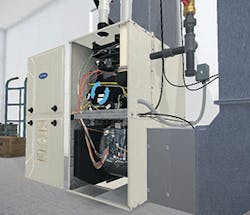CB: What brought about this collaboration between Carrier and Interplay Learning?
Holly Rhodes: “We had some interaction with Interplay Learning over the last several years prior to the release of the VR solution. We were collaborating with them on a different 3D simulation project. We remained in contact with them. Later, we reached the point where we were starting to explore what could be possible with virtual reality, and talked with them about it. They informed us they were releasing their content in VR format as well, so we went on the journey together at that point in time. Carrier’s VR content was released to the field last February.
“Carrier had been exploring virtual reality training for awhile to determine its usability. We liked that Interplay Learning had experience in HVAC in general. We didn’t have to explain HVAC to them, either as a product or as an industry. Their background was in creating HVAC learning materials.”
CB: What are the features Carrier likes about Interplay?
HR: “We are all aware of the technician gap and the need for effective ways to train the next generation of technicians, or give our current technicians a place to scale up, that doesn’t require them to be physically in a classroom or just clicking through an online class.
“We really wanted them to be able to have experience and to be able to practice the action of servicing the equipment. That’s what the virtual reality side of it does. Another thing we really liked about the Interplay solution is that you didn’t have to have a VR kit in order to engage with the content. The content can be learned in a 3D format in a computer simulation, which works perfectly fine. But the virtual reality component helps people remember the experience for a longer period of time.
“Additionally, it’s a safer version of ‘on the job training,’ because you can have inexperienced technicians engaging with equipment without the risk of electric shock, or of damaging the equipment, while still gaining real-life practice.
“It’s very close to a real-life service call. When they’re in the virtual reality environment, they can move throughout the virtual home. They can choose to be outdoors looking at the condenser, or indoors, looking at the unit in the basement. They also have access to meters and tools. They can actually hold a probe and place it where they need to be to take a reading.
“One of the things dealers and their managers say they like is that there is no way the technician can be distracted. They are totally involved and focused on the learning experience.”
CB: Which types of custom VR modules have been created up to this point?
HR: “We have a heat pump module that has been created for us, and there are a couple others that are in the process of being released that we can’t speak to right now, but we definitely are having more Carrier-specific content being developed.”
CB: What are end-users saying they like about it?
HR: “Experienced technicians have said it is a respectful challenge to their skills, versus hearing something they’ve heard many times before. It’s a place to go to ‘sharpen the saw.’
“Newer technicians appreciate seeing how things work. Some are more visual and tactile learners, and they like to be able to see and engage what they’re working with. Company managers like it because the technicians are proving that they have the skill, but then they are also engaging the younger generation into the industry. It’s a useful and attractive way you can train to be an HVAC technician. That’s attractive to the younger market. They can do things that are not possible in the real world. They can virtually stick their head inside an operating furnace, and see how it works without getting hurt.”
CB: Once it’s developed for Carrier, how do dealers gain access? .
HR: “They access all of our training at the ‘My Learning Center.’ Dealers enter a password and log-in information to connect to our HVAC partner sites and the ‘My Learning Center.’”
FIND RELATED INFORMATION HERE.
About the Author
Terry McIver
Content Director - CB
As director of content for Contracting Business, he produces daily content and feature articles for CB's 38,000 print subscribers and many more Internet visitors. He has written hundreds, if not two or three, pieces of news, features and contractor profile articles for CB's audience of quality HVACR contractors. He can also be found covering HVACR industry events or visiting with manufacturers and contractors. He also has significant experience in trade show planning.
